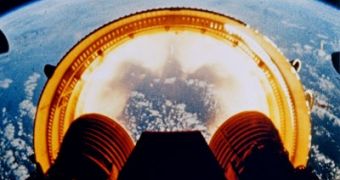There is an enormous number of objects remnant from previous missions currently orbiting Earth, most of which have the potential of seriously damaging spacecrafts intersecting their trajectories. Only last year, the destruction of China's Fengyun-1C satellite left behind about 150,000 individual objects less than a half of an inch in size, and the accumulation of debris will not stop very soon, says NASA's Orbital Debris Program.
Something must be done fast in order to collect at least some of the trash our space program left behind. We may just find ourselves one day stranded on Earth, unable to launch into space because of fear of damage inflicted by a potential collision with one of these objects. Already the effects are clearly seen, some spacecrafts even had to be delayed in order to ensure the structural integrity. Last month, the orbital graveyard just got richer with 3,000 new objects, with the destruction of a U.S. spy satellite which failed to function soon after it was launched.
The biggest concentrations of junk in orbit around the Earth can be found at an altitude of about 2,000 kilometers, while the smallest concentration can be found at 35,785 kilometers above the surface in a geosynchronous orbit. Currently, the U.S. Space Surveillance Network is monitoring about 18,000 objects in orbit around the Earth, five centimeters or more in diameter, however there are probably a few million objects smaller than that.
Most of this debris can reach speeds up to 8 kilometers per second, and is made of Jell-O, foam and stainless steel. Such an object more than five centimeters across could spell disaster one day if it hits a spacecraft. "When it's that big, it travels at orbital velocities and it hits something else, it's going to be a bad day," said Nicholas Johnson, program manager and chief scientist of the NASA Orbital Debris Program Office.
But how does one gather such a massive amount of debris, scattered in such a large volume of space in the smallest time possible?
Potential for disaster
Back in 1996, the French satellite CERISE was hit by an object which resulted from the explosion of a rocket ten days before. Most of the time, such collisions can be avoided by the use of tracking systems, however with such a large amount of debris, a strike may be sometimes inevitable. Further still, on top of the fact that quantity of space junk is ever increasing, collisions between individual bits of debris can create even more bits of debris.
"It's a regeneration process that is going to happen. The only way to prevent it would be to go up there and start removing these large derelict spacecraft and launch vehicles," said Johnson.
Where do they come from?
Most space debris originates in exploding spacecrafts, such as rocket bodies followed closely by spacecrafts which exceeded their life span. The protocol for spacecraft disposal while in orbit clearly states that the owner of the vehicle must follow certain rules to prevent it from exploding, meaning that the spacecraft must be removed from the lower orbit in less than 25 years after it was launched. Therefore, all the satellites falling under this rule must be relocated into higher orbits.
But as we know, rules are made to be broken. Space debris accumulation set a record last year with "The principle reason being the Chinese anti-satellite test. That event alone far exceeded the debris generated in any other year, ever. Unfortunately, it's very long-lived debris; it will be up there for decades or even a century or more," said Johnson.
Clean up operation
Even though the problem originated some time ago and NASA was well aware of it, technical solutions for an eventual clean-up operation are basically inexistent, due to efficiency and cost viability. Hopefully, when the cost will go down we can start thinking about cleaning up the mess we left up there. One of the space cleaning devices proposed by Johnson is the NERF ball, a foamy ball 1.6 kilometers in diameter orbiting through the field of debris.
The idea is that the foam will be able to absorb the energy of the impact and capture the object striking NERF. The problem is that the size and weight of such an object would quickly de-orbit it, to fall back to the surface of Earth.
Alternatives
Lasers have the capability of de-orbiting some of the objects in Earth's lower orbit, but powerful lasers are required for such a job, which not surprisingly are extremely expensive to build.
The trajectory of large space objects could be easily altered by attaching propulsion systems on them, however this would be a selective clean-up, leaving behind smaller objects. Secondly, such a vehicle would be extremely expensive.
These wires attached to spacecrafts could also de-orbit some objects, but they haven't yet been demonstrated in real life experiments, thus have no relevant significance.

 14 DAY TRIAL //
14 DAY TRIAL //